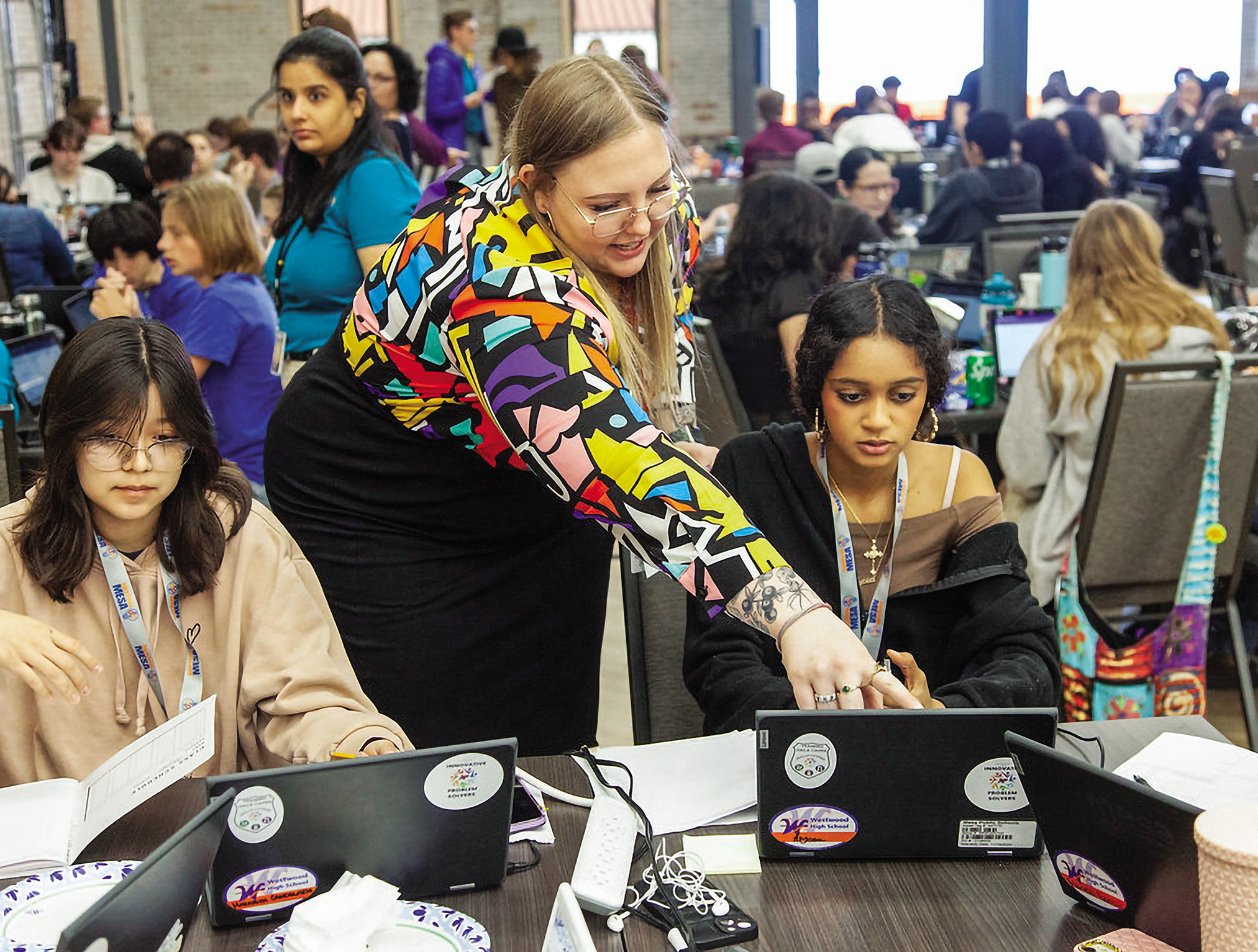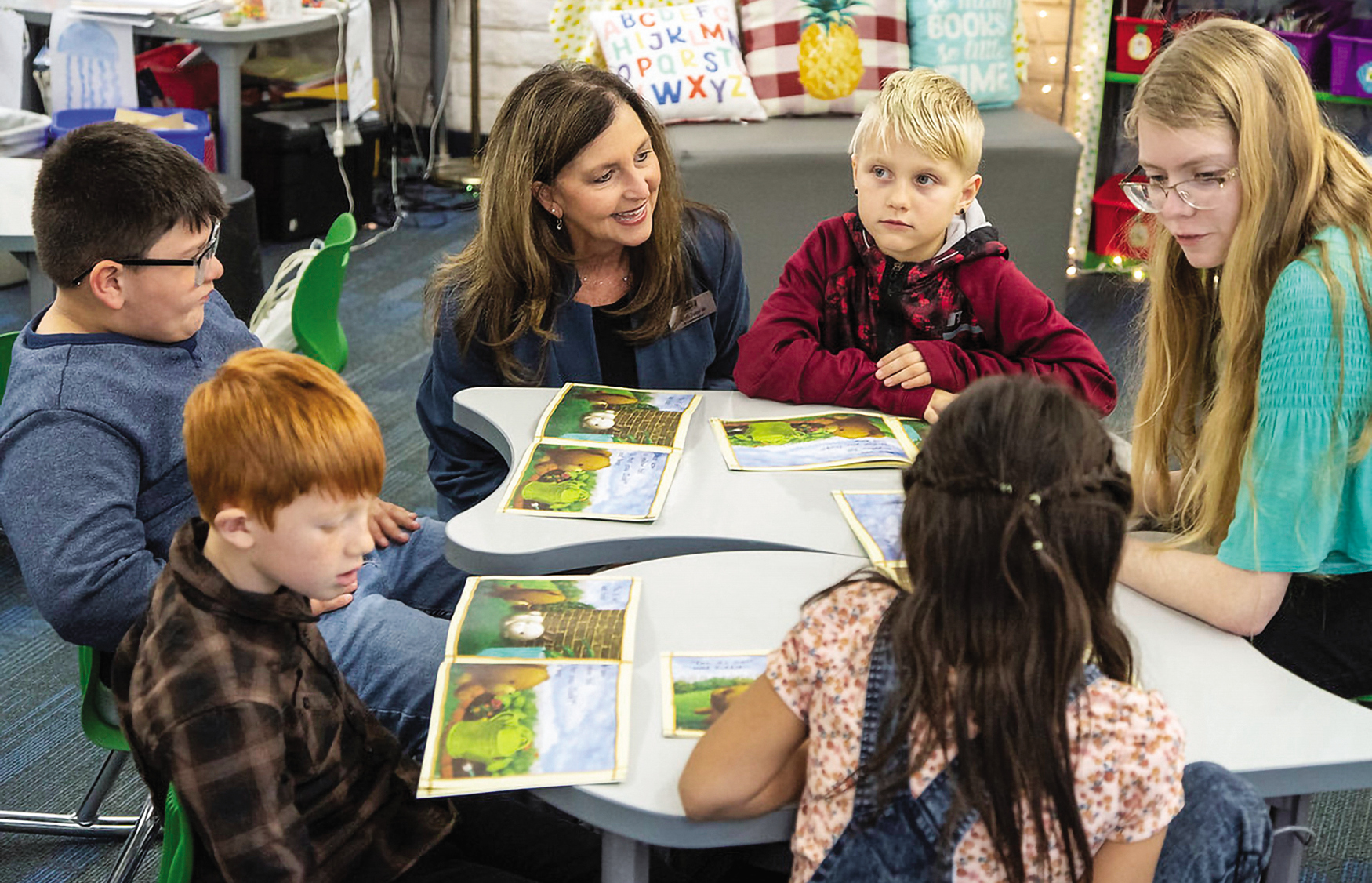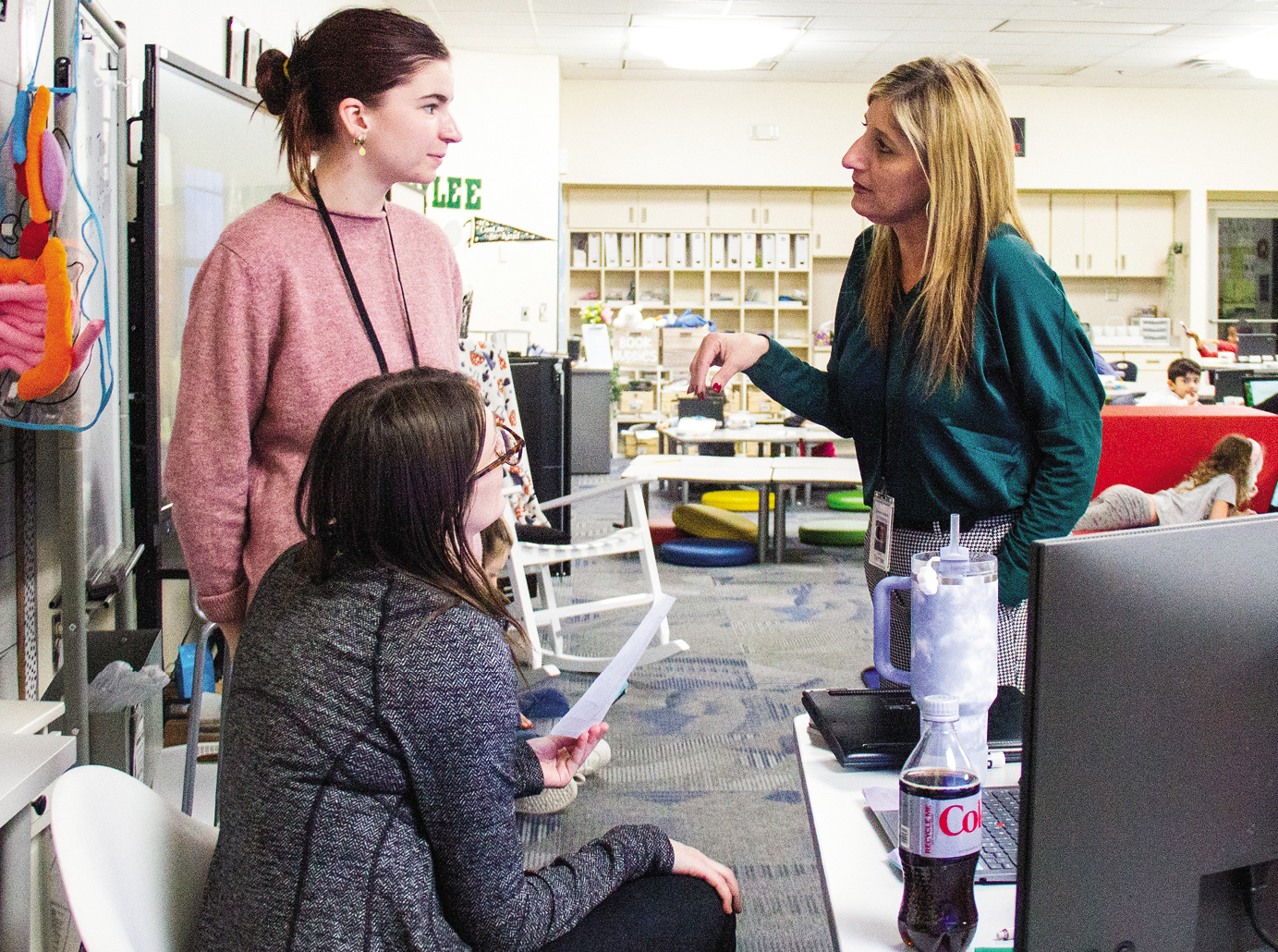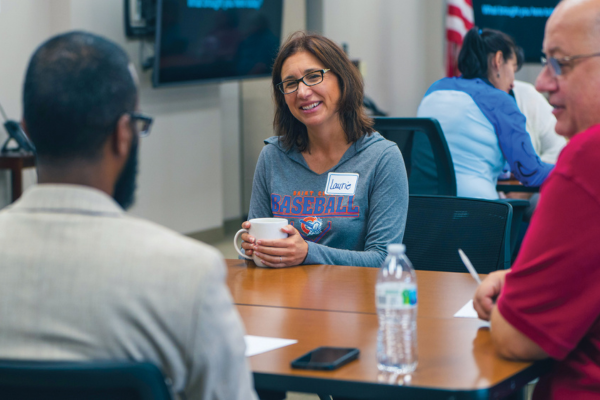A Team Model of Workforce Design
May 01, 2024
Mesa Public Schools’ diverse team teaching practices raise teachers’ job satisfaction while boosting academic support of students

Each morning 700 students hustle into their “family meetings” at Stevenson Elementary School in Mesa, Ariz., to express their learning intentions for the day. Teams of teachers, support staff and specialists work alongside the students to monitor academic progress and the wellness of the learning community.
Team teaching at Stevenson Elementary is one example of how we deliver on our promise to know our 57,000 students by name and to serve them by strength and by need so they graduate ready for college, career and community. To keep this promise, we are transforming how our students learn and how our teachers work.
Thirty years in education has taught me we do not suffer from a teacher shortage. Rather, we suffer from a workforce design problem. We must change the working conditions of teachers if we want to retain and attract teachers and improve student outcomes.
Teachers as Partners
As superintendent of Mesa Public Schools, I and the members of my leadership team made a bold decision in 2020 to break away from the archaic and broken one-teacher one-classroom model. No longer would we expect teachers to work in isolation solving the complex needs of students.
Knowing we needed help, I reached out to Carole Basile, dean of the Mary Lou Fulton Teacher College at Arizona State University. The university’s Next Education Workforce model emerged as a viable solution that continues to evolve as we study the needs of teachers and those they serve. (See right for resources on the Next Education Workforce model.)
To encourage teachers, I made their participation optional and set a goal that at least 50 percent of our 81 schools would have at least one team operating on their campus by the end of the 2023-24 school year. I am proud to share that we have accomplished this goal.
Today, our teaming models include teachers, paraprofessionals, specialists, industry partners and community volunteers as active members who support the social needs of students. Therapy dogs are part of the model. Our teams, by definition, consist of at least two teachers who co-design deeper and personalized learning experiences for a shared roster of students. Working in tandem and using their expertise, the team focuses on creating better learning experiences for students while enhancing their working environments.
Whirlwind of Change
Our first school to adopt a teaming model was Westwood High School in 2019. Its vision for freshmen was radically different from traditional high schools.
Today, four teachers make up the core team that teaches and supports 135 freshmen in flexible learning spaces. An Associated Press reporter characterized it as “organized chaos,” which captures the array of activities taking place simultaneously, from teacher-led instruction to small-group work to project-based learning. Students commented that they like having four teachers who know them well.
The makeover demanded changes in responsibilities, lesson design, school day schedules, common planning time and common teaching time to develop cross-curricular learning. But it is astonishing to see what committed educators have accomplished in three years. Today, 900 freshmen students are served by six academy teams of four teachers each.
Purpose-Driven Teams
Teaming looks different throughout the district, which intrigues visitors to our schools. Some teams are as small as two teachers, with others as large as a house of 600 students.
Some teams have counselors and special education teachers. Others invite community educators such as industry experts to support learning. A K-8 STEM school has aerospace industry experts who join teams throughout the year, while an elementary school sought high school tutors to assist with reading practice two to three times a week. Some of these aspiring educators have been hired as part-time paraprofessionals who join teams after their school day has ended.

I have given permission for our school teams to innovate and move at a pace that works best for their communities. Early adopters were excited to break out of the mold of the one-teacher, one-classroom model. As they come up against challenges, we brainstorm solutions and I reassure them that setbacks are part of progress. I pledge support through district resources and our partnership with Arizona State University.
Multigrade Structures
To strengthen relationships, Stevenson Elementary organizes classes into multigrades: one kindergarten house and six multigrade houses, two each serving grades 1–2, grades 3–4 and grades 5–6. Each house has a dedicated reading, writing, math and innovation teacher, one of whom serves as the team’s lead teacher. The innovation educator leads an inquiry-based class driven by social studies and science standards.
This multigrade model creates stability for students as their teachers monitor growth over a two-year period, reduces yearly transitions from teacher to teacher, deepens relationships with families and develops student leadership.
At Smith Junior High School, teaming has grown from one team supporting 100 7th graders to six teams supporting 900 students. Smith’s teaming journey was initiated by teachers who wanted to increase relevance through cross-curricular projects.
Typically, math and science teachers work with a combined total of 75 students across a two-hour block. English language arts and social studies teachers do the same. Students find comfort knowing they can reach out to any teacher for help. The social studies teacher can provide feedback on a writing assignment, and the math teacher can share another way of understanding a science concept.
Shared Responsibilities
Teacher satisfaction increases when teachers have adequate planning time, an unclouded vision for learning, daily access to expertise and administrators who embrace teacher agency. This is true for beginning and veteran teachers.
Beginning teachers who are on teams don’t navigate their new profession alone. They have daily support from their team leader and teammates. One of our junior high teams takes pride in developing relationships through parent communication. The team leader rehearses difficult conversations with caregivers and joins meetings and phone calls until the beginning teacher is comfortable and confident.
Lead teachers at Stevenson Elementary School not only teach students, but they also guide the team to plan how the members will share responsibility for all elements of instructional planning and delivery (e.g., lesson planning, instruction, data analysis) and work with specialists to design professional learning based on needs and interests of the team. This keeps teachers in the classroom while building leadership skills.
Lessons Learned
Our transformation to teaming has taught us we must bend and break the traditional systems and mindsets as we create instructional models that support personalized learning for all students. What worked for us was a long-term, dual focus on students and teachers. The following lessons served us well.
Create a new vision. Our vision creates pathways for lead teachers to teach students, support colleagues, analyze multiple data points to design instruction, lead the team to develop student-centered scheduling, serve on the school’s instructional leadership team, participate in hiring and ensure their teammates are mentored and coached daily.
Permit a model that can be adapted to different communities. We have learned that success starts small and usually starts with a team of courageous teachers and a visionary leader who wants to solve a complex problem (e.g., literacy skills, student engagement or teacher turnover). A significant strength of Mesa’s approach has been to allow teaming to look different in every school.
Retool existing tools and processes that do not support new models. What was designed for the one-teacher one-classroom model does not match the new models. Teachers usually receive one roster of students based on a class-size formula. Student information systems allow one teacher to view his or her students. Teachers are evaluated as individuals. Daily schedules are created based on time, not student need. Creating alternatives to these entrenched practices takes time.
Seek feedback and support. We have learned we are on the right path. Teachers on teams report high levels of job satisfaction, prompting experienced and novice teachers to work in teaming schools. Positive feedback from parents and students indicates students want to be known by strength and need, which is harder to do in traditional classrooms. This has accelerated the growth of teaming within and across schools.
Leaders benefit from support. Transformation from the status quo can be difficult and slow. I am fortunate to have a thought partner on my team who was willing to walk the first steps on the invisible bridge of leadership with me and who brings others along.
This year we have had a leadership coach dedicated to the expansion and support for teaming models. Because there is no one-size-fits-all model and many moving parts, I wish we would have provided this support sooner.
As we look ahead, we will refine our work to increase teacher retention and ensure our students graduate college, career and community ready.
Andi Fourlis is the superintendent of Mesa Public Schools in Mesa, Ariz.Starting Over: Classrooms Reimagined in Next Education Workforce’s Collaboration
By Laura Toenjes

In the heart of Kyrene School District in Arizona stands a school that appears on the outside to be a classic red brick schoolhouse. Beyond the brick walls, though, is a hub of innovation and educational transformation: Kyrene de las Manitas Innovation Academy.
Committed to engaging and challenging learning for students, the academy is redefining the traditional classroom. At the core is a teaming model that is reshaping the educational experience not only for students, but for teachers too.
In 2019, Kyrene School District launched a pilot on the K-5 campus of Kyrene de las Manitas that reimagined the standard classroom structure by combining innovative practices in learning spaces, instructional delivery and staffing. Initially the program served a multiage cohort of about 75 pupils in 3rd and 4th grade. The overwhelming positive response from families and educators propelled expansion of a second cohort the following year and, in 2022, the Kyrene school board expanded the program schoolwide, making the school a K-8 innovation academy.
As the first school district to fully implement the Next Education Workforce team-based models devised by Arizona State University and its creative education school dean Carole Basile, we are deepening personalized learning for teachers and students. As educators, we know how challenging those transformations can be, particularly for a single teacher working with a group of 25 or more learners in an isolated classroom space.
Transformed Learning
The Manitas teaming model is guided by five key design principles: student-centered learning experiences; educators as designers and facilitators; a culture of community, care and collaboration; equity and inclusion; and transformative learning spaces.
One of the biggest fundamental shifts was the reimagining of physical spaces. Flexible space and scheduling are essential components supporting project-based, collaborative, personalized learning. At Manitas, we don’t have one-teacher, one-room classrooms. We have multiage “learning studios” that can serve up to 120 students, where teams of educators work for the success of all students in the studio.
Step into a learning studio and you’ll find an environment that defies the conventional classroom setup. The studios are characterized by open areas, fewer walls and a diverse range of learning spaces. State-of-the-art technology and flexible furniture further enhance the adaptability of these spaces, enabling collaboration and innovation. The unique design of the studios reflects the academy’s commitment to preparing students for a rapidly changing world.
Learning studios are equipped with movable modular furniture, offering areas for large- and small-group gatherings, maker spaces, quiet reading and reflection, technology stations and performances. Students and educators move fluidly through the open studio spaces to ensure the learning needs of students, and not the bell schedule, drive the use of time and resources.
Staffing Appeal
While implementing the team-based approach was not without its challenges, the impact on both teacher retention and student learning has been substantial.
Finnian “Finn” McLarnon, a kindergarten teacher at Manitas, says he fell in love with the team-teaching model and the learning studios during his time as a student teacher in 2021, so much so that he stayed with Manitas after earning his degree. He accepted an instructional assistant position until a teaching post became available.
“I can’t imagine being a first-year teacher anywhere but Manitas,” McLarnon says. “This model just provides a level of collaboration and creativity to the process that you don’t always see in regular classes.”
Finn also praises the team-based approach for allowing educators more opportunities to collaborate and support each other than in a standard one-teacher-per-classroom setup.
Distinctive Growth
Manitas stands as a testament to the power of reimagining traditional educational models. The Next Education Workforce team-based approach, with its focus on collaborative learning spaces and teacher specialization, not only has enhanced the educational experience but also created a sustainable and rewarding teaching profession.
By surrounding students with teachers in dynamic and flexible environments, we are watching children grow in ways that might not have been possible in a traditional model. Just one year after the board voted to expand to a full-scale model, Kyrene Innovation Academy earned its first A performance rating from the state of Arizona.
Laura Toenjes is superintendent of Kyrene School District in Tempe, Ariz.
Additional Resources
The author recommends these informational resources relating to team teaching, building sustainable models and personalized learning.
- The Next Education Workforce: How Team-based Staffing Models Can Support Equity and Improve Learning Outcome by Carole G. Basile, Brent W. Maddin and R. Lennon Audrain (Rowman & Littlefield, 2023) shares advantages of team-based staffing from creators of the model.
- Next Education Workforce blog features three experts on strategic staffing.
- Next Education Workforce podcasts cover system-level change in education and strategic staffing models.
- School Spotlights feature teaming models in action.
- “What Is the Next Education Workforce?” is a resource collection with videos, podcasts and briefs.
Advertisement
Advertisement
Advertisement
Advertisement



